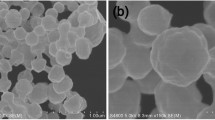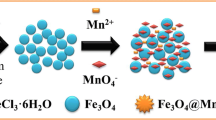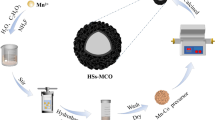Abstract
Hollow structured metal oxides are extensively studied in energy storage and conversion systems. In this work, we report the fabrication of multi-shelled Fe2O3 microspheres with nanospindles assembly on its exterior shell. The β-FeOOH precursor nanospindles were firstly grown on the surface of carbon microspheres to produce β-FeOOH@carbon composites, which were later converted into multi-shelled Fe2O3 microspheres by calcination in air. As electrode material for supercapacitors, the multi-shelled Fe2O3 microspheres exhibit high capacity and good rate capability. The electrode delivers the specific capacitances of 630 and 510 F g−1 at the current densities of 1 and 5 A g−1, respectively.
Abstract
中空结构的金属氧化物在能源储存和转化系统中已被广泛研究. 本文报道了纳米纺锤自组装的多层中空α-Fe2O3微米球. β-FeOOH前 驱体纳米锤首先在炭球表面沉积生长得到β-FeOOH@炭球复合材料, 然后在空气中烧结移除模板, 转变为多层中空α-Fe2O3微米球. 该材料 用作超级电容器的电极材料具有高容量和良好的倍率性能. 该电极在1 和5 A g−1的条件下, 可以释放630和510 F g−1的比放电容量.
Similar content being viewed by others
References
Ma FX, Hu H, Wu HB, et al. Formation of uniform Fe3O4 hollow spheres organized by ultrathin nanosheets and their excellent lithium storage properties. Adv Mater, 2015, 27: 4097–4101
Lou XW, Archer LA, Yang Z. Hollow micro-/nanostructures: synthesis and applications. Adv Mater, 2008, 20: 3987–4019
Shao M, Ning F, Zhao Y, et al. Core–shell layered double hydroxide microspheres with tunable interior architecture for supercapacitors. Chem Mater, 2012, 24: 1192–1197
Lai X, Halpert JE, Wang D. Recent advances in micro-/nano-structured hollow spheres for energy applications: from simple to complex systems. Energy Environ Sci, 2012, 5: 5604–5618
Pan A, Wu HB, Yu L, Lou XW. Template-free synthesis of VO2 hollow microspheres with various interiors and their conversion into V2O5 for lithium-ion batteries. Angew Chem Int Ed, 2013, 52: 2226–2230
Shen L, Yu L, Yu XY, Zhang X, Lou XW. Self-templated formation of uniform NiCo2O4 hollow spheres with complex interior structures for lithium-ion batteries and supercapacitors. Angew Chem Int Ed, 2015, 54: 1868–1872
Wang Y, Pan A, Zhu Q, et al. Facile synthesis of nanorod-assembled multi-shelled Co3O4 hollowmicrospheres for high-performance supercapacitors. J Power Sources, 2014, 272: 107–112
Wu ZG, Zhong YJ, Li JT, et al. L-histidine-assisted template-free hydrothermal synthesis of α-Fe2O3 porous multi-shelled hollow spheres with enhanced lithium storage properties. JMater Chem A, 2014, 2: 12361
Yang Z, Xu F, Zhang W, et al. Controllable preparation of multishelled NiO hollow nanospheres via layer-by-layer self-assembly for supercapacitor application. J Power Sources, 2014, 246: 24–31
Xia C, Alshareef HN. Self-templating scheme for the synthesis of nanostructured transition-metal chalcogenide electrodes for capacitive energy storage. Chem Mater, 2015, 27: 4661–4668
Lou XW, Li CM, Archer LA. Designed synthesis of coaxial SnO2@carbon hollow nanospheres for highly reversible lithium storage. Adv Mater, 2009, 21: 2536–2539
Liu J, Qiao SZ, Budi Hartono S, Lu GQ. Monodisperse yolk-shell nanoparticles with a hierarchical porous structure for delivery vehicles and nanoreactors. Angew Chem Int Ed, 2010, 49: 4981–4985
Wu HB, Pan A, Hng HH, Lou XW. Template-assisted formation of rattle-type V2O5 hollow microspheres with enhanced lithium storage properties. Adv Funct Mater, 2013, 23: 5669–5674
Xu S, Hessel CM, Ren H, et al. α-Fe2O3 multi-shelled hollow microspheres for lithium ion battery anodes with superior capacity and charge retention. Energy Environ Sci, 2014, 7: 632–637
Cho W, Lee YH, Lee HJ, Oh M. Multi ball-in-ball hybrid metal oxides. Adv Mater, 2011, 23: 1720–1723
Lai X, Li J, Korgel BA, et al. General synthesis and gas-sensing properties of multiple-shell metal oxide hollow microspheres. Angew Chem Int Ed, 2011, 50: 2738–2741
Wu J, Zhou A, Huang Z, et al. A facile method to prepare threedimensional Fe2O3/graphene composites as the electrode materials for supercapacitors. Chin J Chem, 2016, 34: 67–72
Zheng X, Yan X, Sun Y, et al. Temperature-dependent electrochemical capacitive performance of the α-Fe2O3 hollownanoshuttles as supercapacitor electrodes. J Colloid Interface Sci, 2016, 466: 291–296
Sun X, Li Y. Colloidal carbon spheres and their core/shell structures with noble-metal nanoparticles. Angew Chem Int Ed, 2004, 43: 597–601
Wang TT, Ma SY, Cheng L, et al. Facile fabrication of multishelled SnO2 hollow microspheres for gas sensing application. Mater Lett, 2016, 164: 56–59
Zhu M, Wang Y, Meng D, Qin X, Diao G. Hydrothermal synthesis of hematite nanoparticles and their electrochemical properties. J Phys Chem C, 2012, 116: 16276–16285
Sethuraman B, Purushothaman KK, Muralidharan G. Synthesis of mesh-like Fe2O3/C nanocomposite via greener route for high performance supercapacitors. RSC Adv, 2014, 4: 4631–4637
Yang S, Song X, Zhang P, Gao L. Heating-rate-induced porous α-Fe2O3 with controllable pore size and crystallinity grown on graphene for supercapacitors. ACS Appl Mater Interfaces, 2015, 7: 75–79
Author information
Authors and Affiliations
Corresponding author
Additional information
The authors contributed equally to this work.
Zhiwei Nie received his bachelor degree fromNorth China University of Science and Technology in 2013. He is currently a graduate student at the School ofMaterials Science and Engineering, Central SouthUniversity. His current research focuses on hollow-structured materials for electrochemical energy storage application.
Yaping Wang received her BE degree inmineral process engineering fromCentral South University in 2013. Currently, she is a graduate student under the guidance of Prof. Pan at the School of Materials Science and Engineering, Central South University. Her current research interest is hollow-structured materials for supercapacitors.
Anqiang Pan is currently a Sheng-Hua Professor at the School of Materials Science & Engineering, Central South University. He got his PhD degree in 2011 fromCentral South University and then worked at theUniversity ofWashington, Pacific Northwest National Laboratory and Nanyang Technological University. His current interests are on lithium ion batteries and supercapacitors.
Rights and permissions
About this article
Cite this article
Nie, Z., Wang, Y., Zhang, Y. et al. Multi-shelled α-Fe2O3 microspheres for high-rate supercapacitors. Sci. China Mater. 59, 247–253 (2016). https://doi.org/10.1007/s40843-016-5028-8
Received:
Accepted:
Published:
Issue Date:
DOI: https://doi.org/10.1007/s40843-016-5028-8




